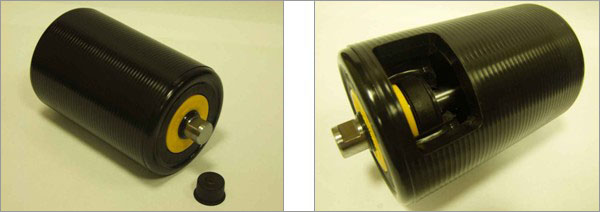
![]()
PRODUCTS |
||||||||
| CONVEYOR BELT ROLLERS |
where there is a small or medium load
|
|
where material is coming from a small height onto the belt |

2. Rubber disc rollers
Available roller diameters:
51 mm - 63,5 mm - 89 mm - 108 mm - 133 mm - 159 mm.
Wall thickness of the roller shell: 3,0 mm or 3,6 mm upon request.
Bearing: 6204C3
Sealing: 5-element labyrint sealing.
Rollers are primer painted or epoxy painted.
Rollers at loading stations are exposed to bigger damages and more wear than in other sections of the conveyor structure. The material is not simply rolling over the rollers but it reaches the belt at this point hitting it heavily. The energy of the incoming big and heavy pieces is not absorbed only by the belt, but also by the rollers supporting it. These hits harm the bearings of the rollers. To be able to grant a longer lifetime even under loading stations we recommend to use rubber disc rollers (impact rollers). The rubber rings on the roller shell absorb lots of hitting energy and protect the steel roller.
On return side:
It is worth to use disc rollers even under the return side of the rubber belt. If material is too sticky and scrapers cannot perfectly remove it, it remains on the belt and begins to build up on the surface of the rollers, making them unevenly thicker, causing misalignment of the belt.
Also the abrasion effect is important, as the normally 3 mm thick roller shells wear easily if material is abrasive.
By using rubber disc rollers all these problems can be avoided.
It is worth to use disc rollers even under the return side of the rubber belt. If material is too sticky and scrapers cannot perfectly remove it, it remains on the belt and begins to build up on the surface of the rollers, making them unevenly thicker, causing misalignment of the belt.
Also the abrasion effect is important, as the normally 3 mm thick roller shells wear easily if material is abrasive.
By using rubber disc rollers all these problems can be avoided.

In an agressive environment with possible chemical effects which can easily harm metals, we recommend to use HDPE rollers where the roller shell and the sealings are made of HDPE.
These rollers come in consideration when the light weight of the complete srtucture is an important factor. Weight of HDPE rollers is about 55 % less than weight of the same size steel rollers.
They are even less noisy than steel rollers. It is proven by tests that noise pollution in the environment of the structure was reduced by 10 dB after having changed the steel rollers to HDPE rollers.
HDPE is very much wear-resistant, but when it wears there are no holes onthe roller shell, because wall is thicker. After wearing so much the edges of the shell do not become sharp, so there is no danger of cutting the rubber belt by a damaged roller.
These rollers come in consideration when the light weight of the complete srtucture is an important factor. Weight of HDPE rollers is about 55 % less than weight of the same size steel rollers.
They are even less noisy than steel rollers. It is proven by tests that noise pollution in the environment of the structure was reduced by 10 dB after having changed the steel rollers to HDPE rollers.
HDPE is very much wear-resistant, but when it wears there are no holes onthe roller shell, because wall is thicker. After wearing so much the edges of the shell do not become sharp, so there is no danger of cutting the rubber belt by a damaged roller.

The advantages of the standard HDPE rollers and the very massive, strong steel rollers are united in the EU Roller which is a high technology heavy duty roller.
Weight of EU Roller is about 60 % of the weight of the same size steel roller. It is easy to change and the smaller weight is also better for the structure.
EU Roller is an ideal choice for environment protection (in case of restrictions of authorities). At a belt speed of 6,5 m/sec it only makes 57 dB noise.
Due to the thickness of the wall there can no holes occur on the roller shell and there will not be any sharp edges.
Weight of EU Roller is about 60 % of the weight of the same size steel roller. It is easy to change and the smaller weight is also better for the structure.
EU Roller is an ideal choice for environment protection (in case of restrictions of authorities). At a belt speed of 6,5 m/sec it only makes 57 dB noise.
Due to the thickness of the wall there can no holes occur on the roller shell and there will not be any sharp edges.
Available diameters: 133 mm - 159 mm - 194 mm
Wall thickness: 2 mm steel pipe and a 14 or 19 mm thick HDPE wall.
Sealing: 4-elements, patented.
The roller is used by clinets just like ISD Dunaferr Zrt. (steel plant and coke plant) where there are extreme loads and challenges, rollers still have to cope with them.
Wall thickness: 2 mm steel pipe and a 14 or 19 mm thick HDPE wall.
Sealing: 4-elements, patented.
The roller is used by clinets just like ISD Dunaferr Zrt. (steel plant and coke plant) where there are extreme loads and challenges, rollers still have to cope with them.

